Assessment resources
Drawing skills videos
One Assessment Tool for ALL your assessments. Single Point Rubric: A Tool for Responsible Student Self Assessme. Your Rubric Is a Hot Mess; Here’s How to Fix It.
Share with Friends 28.1KShares See Mrs.
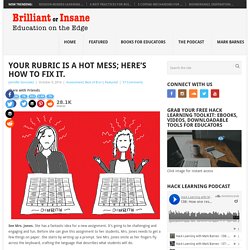
Jones. She has a fantastic idea for a new assignment. It’s going to be challenging and engaging and fun. Then it’s time to build a rubric. See Mrs. If you’re like Mrs. Then, when it comes time to assess student work, you’re likely to find many assignments that don’t fit neatly into any one column. And do students even read these rubrics? Might there be a better way? Instead of detailing all the different ways an assignment deviates from the target, the single-point rubric simply describes the target, using a single column of traits.
For some, this alternative might cause apprehension: does this mean more writing for the teacher? With a single-point rubric, the farce of searching for the right pre-scripted language is over, leaving you free to describe exactly what this student needs to work on. Is there ever a need for a fully loaded, “hot mess” rubric? But a teacher aspires to more than that. You and me and Mrs. About The Author Jennifer Gonzalez. How do You Remove the Unused Parts of Cropped Screenshots in Microsoft Office Documents?
When you add a screenshot to a Microsoft Office document and crop it, you most likely give no further thought to the unused portions, but did you know that they are still there and could pose a security risk if they contain sensitive information?
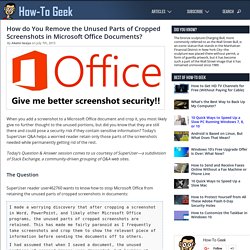
Today’s SuperUser Q&A helps a worried reader retain only those parts of the screenshots needed while permanently getting rid of the rest. Today’s Question & Answer session comes to us courtesy of SuperUser—a subdivision of Stack Exchange, a community-driven grouping of Q&A web sites. The Question SuperUser reader user462760 wants to know how to stop Microsoft Office from retaining the unused parts of cropped screenshots in documents: I made a worrying discovery that after cropping a screenshot in Word, PowerPoint, and likely other Microsoft Office programs, the unused parts of cropped screenshots are retained.
Is there a way to stop Microsoft Office from retaining the unused parts of cropped screenshots in documents?
How to Make Time for Reflection in the Arts Classroom. Let’s be honest, when an art project goes long, or a class is a little crazy, structured reflection is the first thing to go.
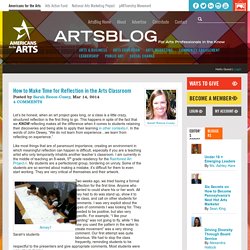
This happens in spite of the fact that we KNOW reflecting makes all the difference when it comes to students retaining their discoveries and being able to apply their learning in other contexts. In the words of John Dewey, “We do not learn from experience…we learn from reflecting on experience.” Like most things that are of paramount importance, creating an environment in which meaningful reflection can happen is difficult, especially if you are a teaching artist who only temporarily inhabits another teacher’s classroom.
I am currently in the middle of teaching an 8-week, 5th grade residency for the Rainforest Art Project. My students are a perfectionist group, bordering on unruly. Two weeks ago, we tried having a formal reflection for the first time. Last week we repeated the process. Garrick8 1. 2. 3. 4. 5.
The Secret to Drawing Meaningful Reflection Out of Your Students - The Art of Ed. If your students blog about their art as mine currently do, you understand the rich reflection that blogging can produce.
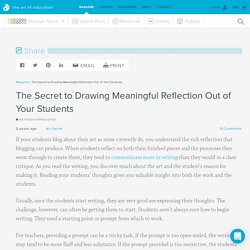
When students reflect on both their finished pieces and the processes they went through to create them, they tend to communicate more in writing than they would in a class critique. As you read the writing, you discover much about the art and the student’s reason for making it. Reading your students’ thoughts gives you valuable insight into both the work and the students. Usually, once the students start writing, they are very good are expressing their thoughts. The challenge, however, can often be getting them to start. For teachers, providing a prompt can be a tricky task.
The answer is to use artistic behaviors as prompts. A coworker of mine at Apex High School, Melissa Purtee, developed a set of this type of prompt. So, how do students apply these prompts?
The Secret to Drawing Meaningful Reflection Out of Your Students - The Art of Ed. The Other 21st Century Skills: Educator Self-Assessment. Chartkamp–I think I understand what you are saying, but in any scenario, someone, or something will spur the impetus for learning to occur.
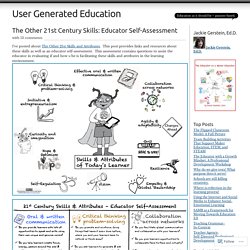
We could have a toddler go about and learn the world from scratch, but I don’t think anyone would say that is as efficient and as effective as a “parent” facilitating, or at least providing for a safe environment. And the better the parent, the more effective the toddler will be at contributing to the learning within the community as he/she progresses. Can you describe what you mean by informal learning?
I can take that to be exploratory, on your own, as equals, not in a classroom, and so many more ways.
Amazon.





